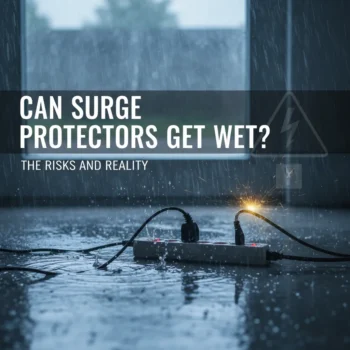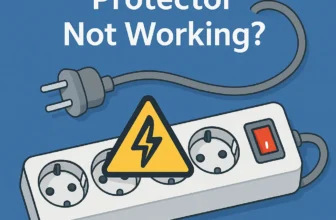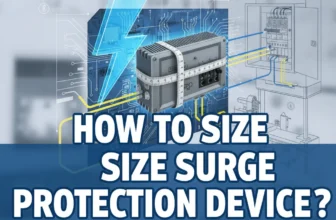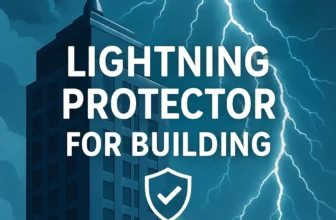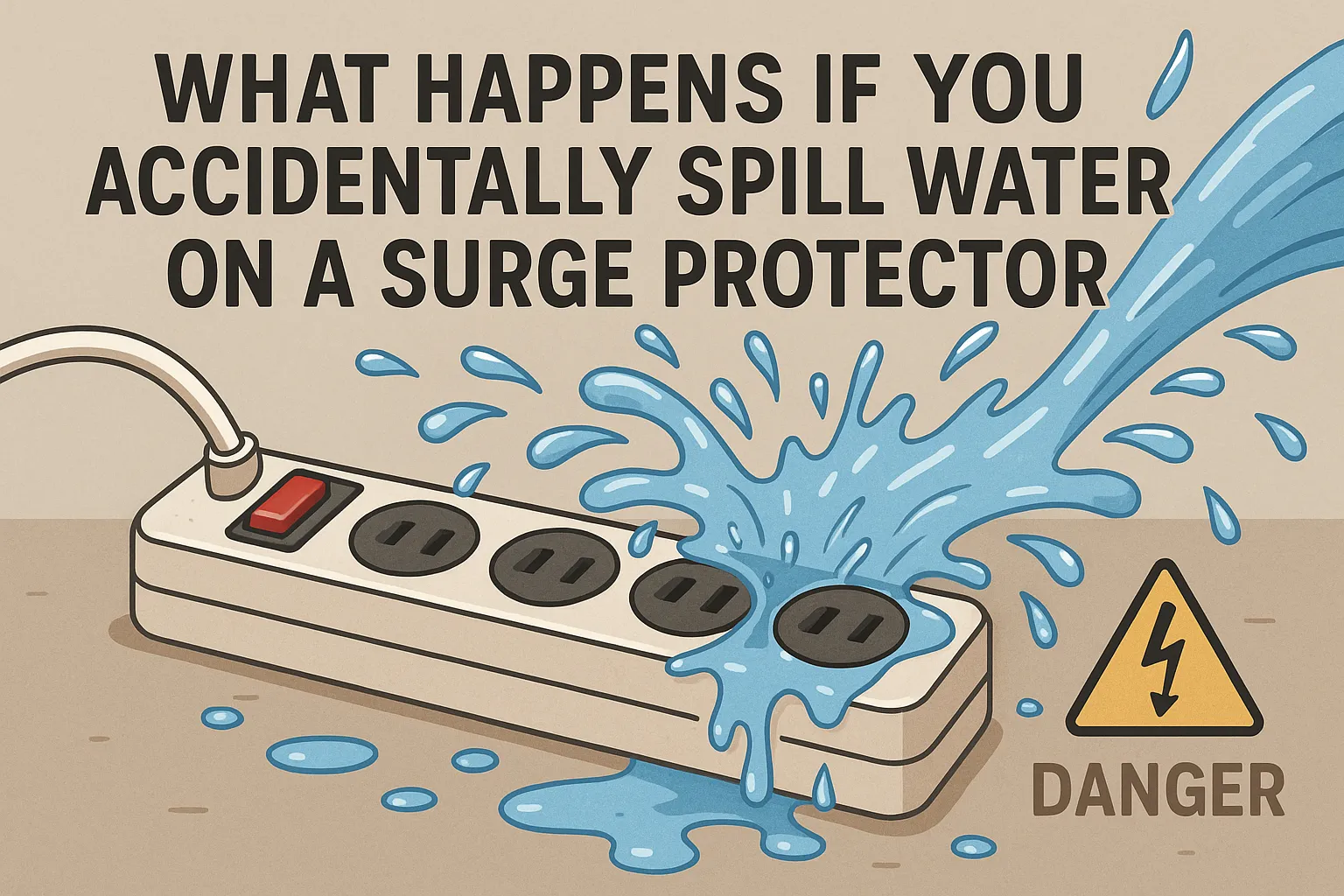
Unless you have an outdoor surge protector, residential surge protection devices and water don’t mix. Spilled water on such devices can lead to dangerous outcomes. You risk electrical shock, short circuits, or even a fire. Wondering what happens if you ignore it? The consequences can escalate quickly. Can surge protectors get wet? Absolutely not. Treat every liquid accident as a serious hazard.
Can Surge Protectors Get Wet? Immediate Risks
When a surge protector inside your home gets wet, it creates a dangerous situation. Water conducts electricity, which can lead to severe consequences if not addressed immediately.
Let’s explore the immediate risks you face when a surge protector comes into contact with water.
Electrical Shock and Fire Hazards
Water and electricity are a hazardous combination. If your surge protector gets wet, it can cause electrical shock when touched. This happens because water allows electrical currents to flow freely, increasing the risk of electrocution. A wet power strip can also spark, potentially igniting a fire. Electrical fires often occur when water damages internal components, causing short circuits.
These risks highlight why you must act quickly if spilled water reaches your surge protector.
Damage to Connected Devices
A surge protector doesn’t just protect your devices from power surges; it also connects them to a single power source. When it gets wet, the water can travel through the circuits and damage your plugged-in devices. This damage may be irreversible, especially for sensitive electronics like computers or gaming consoles. You might notice flickering screens, malfunctioning hardware, or complete device failure. Disconnecting your devices immediately can help minimize the damage.
Hazards of a Wet Electrical Outlet
A wet outlet poses even greater risks. Short circuits can occur, leading to electrical fires. Internal wiring may suffer damage, requiring costly repairs. A live electrical current in a wet outlet increases the risk of electrocution. Turning off the power at the breaker box is essential to prevent these dangers. Corrosion from moisture exposure can also weaken the outlet over time, making it unsafe for future use.
Understanding the hazards of a wet electrical outlet underscores the importance of keeping water away from all electrical components.
What to Do After Spilled Water on a Surge Protector
Unplugging the Surge Protector Safely
Your first step after spilled water reaches a surge protector is to unplug it. However, safety comes first. Never touch the surge protector or its connected devices if they are wet. Instead, shut off the breaker box to cut power to the outlet. This action eliminates the risk of electrical shock. Once the power is off, carefully unplug the surge protector.
If the outlet is a GFCI (Ground Fault Circuit Interrupter), you may need to reset it later. Knowing what to do if a GFCI outlet gets wet can prevent further complications.
Turning Off the Power Source
After unplugging the surge protector, turn off the power source completely. Locate your home’s breaker box and shut off the circuit connected to the affected outlet. This step ensures no electricity flows through the outlet or the surge protector. If you’re unsure which breaker controls the outlet, it’s safer to shut off the main breaker.
This precaution minimizes risks like short circuits or electrical fires.
Drying the Surge Protector
Once the power is off, focus on drying the surge protector. Use a clean, dry cloth to remove visible moisture. Avoid using heat sources like hair dryers, as they can damage internal components. If an extension cord is attached, dry the extension cord thoroughly. Hang the extension cord to dry in a well-ventilated area. Ensure every part of the surge protector and cord is completely dry before proceeding.
Avoiding Use Until Inspected
Never use a surge protector that has been exposed to water until it has been inspected. Even if it appears dry, internal damage may still exist. If you’re unsure about its condition, consult a professional electrician. They can assess whether the surge protector is safe to use or if it needs replacement.
Understanding what happens if you reuse a damaged surge protector can save you from potential hazards.
Assessing Damage and Replacement
Signs of Irreparable Damage
After water exposure, you need to inspect the surge protector for visible signs of damage. Some indicators suggest the device is beyond repair. Look for physical damage like burnt or melted components. A charred circuit board is another clear sign of irreparable harm. If you notice a strong odor of burnt plastic, the internal components may have been compromised.
Cracks, frayed wires, or loose connections also mean the surge protector is no longer safe to use. Ignoring these signs can lead to serious risks, especially if you’ve connected a faulty surge protector to your devices.
Consulting a Professional
If you’re unsure about the condition of your surge protector, consulting a professional electrician is the safest option. They can assess whether the device is still functional or if it poses a hazard. A professional inspection ensures you don’t unknowingly use a faulty surge protector. This step is especially important if the device powers multiple electronics through an extension cord.
An expert can also advise on whether the outlet or extension cord connected to the surge protector has sustained damage.
When to Replace the Surge Protector
Replacing the surge protector is necessary in several situations. Physical damage, such as cracks or frayed wires, requires immediate replacement. If the device has experienced a significant power surge, its effectiveness may be compromised. Regular inspections are essential, even if no water damage occurs. Surge protectors should be replaced every 2 to 3 years to maintain optimal performance.
Using an old or faulty surge protector increases the risk of damaging your devices, especially when connected through an extension cord.
Preventing Future Water Spills
Keeping Surge Protectors Away from Liquids
You can avoid water-related accidents by placing your surge protector in a safe, dry location. Keep it away from areas prone to spills, such as kitchen counters, bathroom sinks, or coffee tables. If you use an extension cord to connect your surge protector, ensure the cord doesn’t run near water sources. Elevating the surge protector off the floor can also help protect it from accidental spills or leaks.
Simple adjustments to your setup can significantly reduce the risk of water exposure.
Using Protective Covers
Protective covers offer an extra layer of safety for your surge protector. These covers shield the device from accidental spills and dust accumulation. Some models are specifically designed for wet environments, offering enhanced moisture resistance. For example, surge protectors built for damp locations undergo rigorous testing, including high-temperature and humidity evaluations.
The table below highlights key differences between standard surge protectors and those designed for wet environments:
|
Feature |
Standard Surge Protectors |
Wet Environment Surge Protectors |
|---|---|---|
|
UL 1449 Standard |
Basic requirements |
Updated with specific tests for damp locations |
|
Testing Conditions |
General conditions |
High temperature and humidity tests (e.g., 85°C/85% humidity) |
|
Performance Evaluation |
Standard reliability tests |
Additional tests for moisture resistance and aging |
|
Application |
Indoor use |
Suitable for outdoor and humid environments |
Investing in a protective cover or a surge protector designed for wet environments can safeguard your devices and reduce risks.
Installing a GFCI Outlet for Safety
Installing a GFCI outlet is one of the most effective ways to enhance safety in areas prone to water exposure. These outlets act as a safety net by cutting off power almost instantly when they detect faults. They continuously monitor electrical current flow and trip when they sense imbalances as small as 4 or 5 milliamps. This reaction, which occurs in less than one-tenth of a second, prevents electrocution in environments where water and electricity may intersect.
GFCI outlets are especially beneficial for protecting vulnerable groups like children and the elderly. Use them in areas like kitchens, bathrooms, and outdoor spaces to minimize risks. Pairing a GFCI outlet with your surge protector ensures maximum safety for your home.
Water exposure to a surge protector creates serious safety risks. You must act immediately to unplug the device and dry it completely. Inspect its condition before using it again. Prevention plays a vital role in avoiding future accidents. Keep your surge protector away from liquids and use protective measures to ensure long-term safety.
FAQ
What should you do if water spills on a surge protector during use?
Turn off the power at the breaker box immediately. Then, unplug the surge protector carefully. Avoid touching it until you ensure it’s completely dry.
Can a surge protector still work after water exposure?
It depends on the extent of the damage. Visible signs like burns or frayed wires mean replacement is necessary. Always consult a professional if unsure.
How can you prevent water damage to a surge protector?
Place it in a dry, elevated location. Use protective covers designed for wet environments. Installing a GFCI outlet adds an extra layer of safety.

